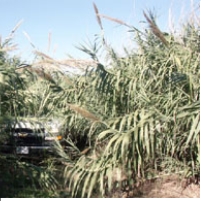Herbicide Spraying in Texas: Border Patrol vs. Locals
 Carrizo cane
Carrizo cane
Residents of Laredo, Texas are objecting to a recent Border Patrol decision to spray the Rio Grande river bank with pesticides, claiming that it has echoes of the Agent Orange scandal of the Vietnam War era. Border patrol officials proposed spraying the herbicide imazapyr from helicopters in order to control the dense carrizo grass that covers vast portions of the Rio Grande river bank and obstructs the Border Patrol's vision of the border crossing. The carrizo cane, which can grow up to 30 feet high at the rapid rate of 4 inches per day, has become an obstacle for the Border Patrol in spotting drug smugglers and immigrants illegally crossing the U.S.-Mexico border. The U.S. Border Patrol planned to begin spraying March 25, but halted operations when the city councils of Laredo and its counterpart city on the other side of the border, Nuevo Laredo, protested the use of the chemical, fearing contamination of their drinking water.
- Top Stories
- Unusual News
- Where is the Money Going?
- Controversies
- U.S. and the World
- Appointments and Resignations
- Latest News
- Trump to Stop Deportations If…
- Trump Denounces World Series
- What If China Invaded the United States?
- Donald Trump Has a Mental Health Problem and It Has a Name
- Trump Goes on Renaming Frenzy






Comments